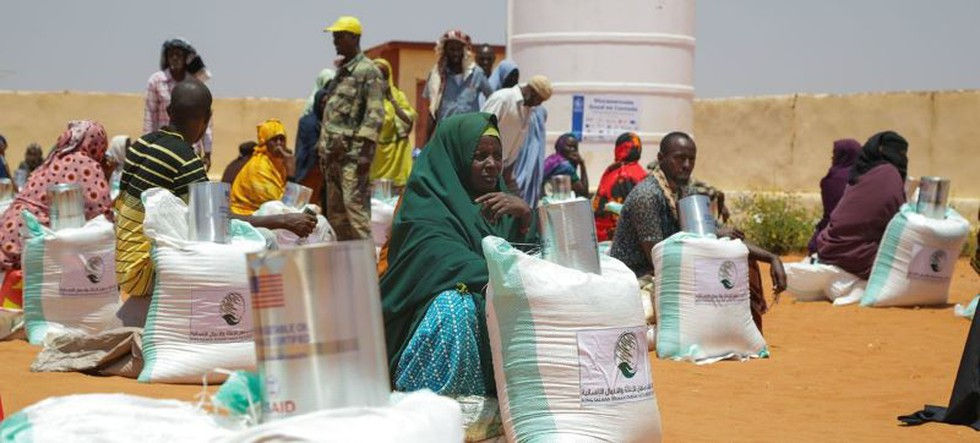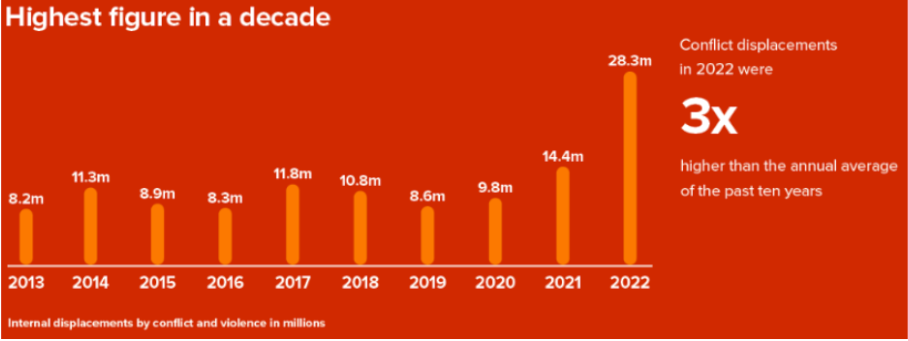Description

Disclaimer: Copyright infringement is not intended.
Context:
- Weather-related disasters continue to displace more than conflict and violence
Global Report on Internal Displacement 2024 (GRID-2024) Overview:
Increase in Internally Displaced People:
- The number of internally displaced people (IDPs) rose to 75.9 million in 2023, up from 71.1 million in 2022.
|
●Internal displacement is defined by IDMC as the number of forced movements of people within their country's borders recorded during a year.
|
Trend Reversal in Displacement Causes:
- Historically, weather-related disasters displaced more people than conflict and violence.
- In 2022-2023, conflict and violence became the primary causes of displacement again.
Conflict and Violence:
- By the end of 2023, 68.3 million people were living in displacement due to conflict and violence, the highest since data collection began.
- Countries with the highest numbers of conflict-induced IDPs: Sudan, Syria, the Democratic Republic of the Congo (DRC), Colombia, and Yemen.

Disaster-Induced Displacement:
- Disaster-induced displacement was 7.7 million by the end of 2023, with a quarter due to earthquakes.
- Disaster displacement was detected in 148 countries and territories, with significant events across six continents.
- High-income countries like Canada and New Zealand reported their highest figures of disaster displacement.
Weather-Related Disasters:
- Internal displacement due to weather-related disasters decreased by a third in 2023 compared to 2022.
- Despite the dip, weather-related disasters caused 56% of all internal displacement in 2023.
- Weather-related displacement in 2023 was the third highest in the last decade.
Impact of Global Weather Phenomena:
- The decrease in weather-related displacement in 2023 is attributed to the transition from La Niña to El Niño.
- La Niña, associated with more storms and floods, ended, and El Niño, associated with dry weather and droughts, began.
- Storms and floods led to fewer displacements in Asia, but floods in other regions like the Horn of Africa led to high number of displacements.

Regional Analysis:
- South Asia reported its lowest displacement figures in recent years, with 3.7 million internal displacements in 2023, mostly due to disasters (3.6 million).
- The lower displacement figure in South Asia is partly due to El Niño causing below-average rainfall and a weaker cyclone season.
Continuing Displacement Trends:
- Despite fewer overall displacements due to weather-related disasters, floods and storms continued to affect regions with recurrent displacement.
- In 2022, La Niña led to an increase in weather-related displacements by 40% compared to 2021, with 98% of these displacements triggered by floods and storms.I
Previous Trends:
- The three-year-long La Niña from 2020 to 2022 resulted in significant increases in weather-related displacements.
- In 2022, floods were the primary cause of disaster displacements, surpassing storms for the first time since 2016.
|
Global Report on Internal Displacement 2024 (GRID-2024)
●It is an annual report published by the Geneva-based Internal Displacement Monitoring Centre (IDMC).
●It records internal displacements due to conflict violence and disasters.
About IDMC
●The Internal Displacement Monitoring Centre (IDMC) is the world's leading source of data and analysis on internal displacement.
●Established in 1998 as part of the Norwegian Refugee Council (NRC).
●Their work informs policy and operational decisions that improve the lives of the millions of people living in internal displacement or at risk of becoming displaced in the future.
|
Source:
https://www.downtoearth.org.in/news/climate-change/weather-related-disasters-continue-to-displace-more-than-conflict-and-violence-96147
|
PRACTICE QUESTION
Q. Discuss the changing dynamics of internal displacement with a focus on the trends in weather-related disasters and conflict-induced displacement, as highlighted in the Global Report on Internal Displacement 2024 (GRID-2024). (250 words)
|
Array
(
[0] => daily-current-affairs/global-report-on-internal-displacement-2024
[1] => daily-current-affairs
[2] => global-report-on-internal-displacement-2024
)










